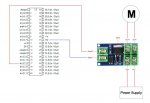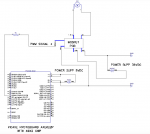Manuel Pinto
Member
Hello.
Iam very new with picaxe micro.
I try to make a pwm code for picaxe 40x2 with pcb mosfet and optocopler like
on the circuit attach.
When i test it the velocity of the motor not change.
Please seee the image here:

The code here:
I need put any type of resistor on the PWM pin?
Can someone help?
Thanks
Manuel
Iam very new with picaxe micro.
I try to make a pwm code for picaxe 40x2 with pcb mosfet and optocopler like
on the circuit attach.
When i test it the velocity of the motor not change.
Please seee the image here:

The code here:
Code:
#picaxe 40x2
main:
pwmout C.2, 99, 99 ; 10000Hz at 25% @ 4MHz
pause 3000
pwmout C.2, 99, 199 ; 10000Hz at 50% @ 4MHz
pause 3000
pwmout C.2, 99, 299 ; 10000Hz at 75% @ 4MHz
pause 3000
pwmout C.2, 99, 399 ; 10000Hz at 100% @ 4MHz
pause 3000
goto mainCan someone help?
Thanks
Manuel


